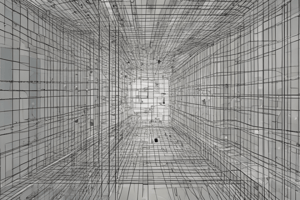Podcast
Questions and Answers
Which of the following best describes 'growth' in the context of human development?
Which of the following best describes 'growth' in the context of human development?
- Advancement from lower to more advanced stages of complexity.
- The physical changes across a person's lifespan, resulting in increased size and weight. (correct)
- A process of change leading to increased skill and capacity to function.
- The interaction between biological, psychological, sociocultural, and environmental factors.
What is the primary focus of family-centered care?
What is the primary focus of family-centered care?
- Minimizing family involvement in healthcare decisions to streamline processes.
- Working 'with' patients and families, respecting their expertise and promoting collaboration. (correct)
- Providing care 'to' families based on the healthcare provider's assessment.
- Directing families in caregiving based on established medical protocols.
Which intervention aligns with the principles of atraumatic care?
Which intervention aligns with the principles of atraumatic care?
- Minimizing explanation to avoid anxiety.
- Performing procedures quickly to minimize distress.
- Restricting choices to maintain control.
- Encouraging parental presence and involvement. (correct)
What is a key difference between how growth and development were historically viewed versus how they are understood today?
What is a key difference between how growth and development were historically viewed versus how they are understood today?
Which of the following factors influencing growth and development falls under the category of 'health environment'?
Which of the following factors influencing growth and development falls under the category of 'health environment'?
A nurse is caring for an infant between 6-18 months. Which of the following social developments is expected at this age?
A nurse is caring for an infant between 6-18 months. Which of the following social developments is expected at this age?
Which of the following represents a common health risk for infants (6-18 months)?
Which of the following represents a common health risk for infants (6-18 months)?
A 2-year-old toddler is brought in for a checkup. Which of the following intellectual milestones is MOST likely to be observed?
A 2-year-old toddler is brought in for a checkup. Which of the following intellectual milestones is MOST likely to be observed?
Which nursing action best demonstrates support for family-centered care when a child requires a lengthy hospital stay?
Which nursing action best demonstrates support for family-centered care when a child requires a lengthy hospital stay?
A school-age child is admitted to the hospital. Which nursing intervention best supports their social development during hospitalization?
A school-age child is admitted to the hospital. Which nursing intervention best supports their social development during hospitalization?
A nurse is educating a group of adolescents about common health risks. Which of the following should the nurse emphasize?
A nurse is educating a group of adolescents about common health risks. Which of the following should the nurse emphasize?
What is the MOST important consideration when applying the principles of atraumatic care to a toddler undergoing a painful procedure?
What is the MOST important consideration when applying the principles of atraumatic care to a toddler undergoing a painful procedure?
A nurse is planning care for a child with a chronic illness. Which intervention best supports the child's resilience?
A nurse is planning care for a child with a chronic illness. Which intervention best supports the child's resilience?
What nursing intervention is MOST likely to promote resilience in a young, single woman dealing with the birth of her first child?
What nursing intervention is MOST likely to promote resilience in a young, single woman dealing with the birth of her first child?
Which factor at the community level would MOST likely promote resilience in families facing poverty?
Which factor at the community level would MOST likely promote resilience in families facing poverty?
Which of the following nursing actions reflects an understanding of the individual factors that promote resilience?
Which of the following nursing actions reflects an understanding of the individual factors that promote resilience?
A nurse is working with a family experiencing a crisis. What family-level process would be MOST indicative of resilience?
A nurse is working with a family experiencing a crisis. What family-level process would be MOST indicative of resilience?
A nurse is caring for a child experiencing physical distress which includes loud noises and bright lights from the care interventions. How would the nurse minimize the stressors?
A nurse is caring for a child experiencing physical distress which includes loud noises and bright lights from the care interventions. How would the nurse minimize the stressors?
A nurse is caring for a child who is experiencing anxiety, fear, and anger about their care. Which type of care should the nurse focus on?
A nurse is caring for a child who is experiencing anxiety, fear, and anger about their care. Which type of care should the nurse focus on?
According to the principles of family-centered care, what should nurses focus on?
According to the principles of family-centered care, what should nurses focus on?
Flashcards
Resiliency
Resiliency
Focuses on interaction between protective and vulnerability processes.
Vulnerability processes
Vulnerability processes
Physical illness, psychological stress, and social risk.
Individual factors promoting resilience
Individual factors promoting resilience
Self-efficacy, positive attitude, and social competence.
Family-level processes
Family-level processes
Signup and view all the flashcards
Community level factors
Community level factors
Signup and view all the flashcards
Resilience & family adaptation theory
Resilience & family adaptation theory
Signup and view all the flashcards
Common Health Risks in Adolescence
Common Health Risks in Adolescence
Signup and view all the flashcards
Pediatric Health Problems
Pediatric Health Problems
Signup and view all the flashcards
Determinants of health
Determinants of health
Signup and view all the flashcards
Conditions on the rise
Conditions on the rise
Signup and view all the flashcards
Health risks
Health risks
Signup and view all the flashcards
Health concerns
Health concerns
Signup and view all the flashcards
Adolescence
Adolescence
Signup and view all the flashcards
Intellectual development in adolescence
Intellectual development in adolescence
Signup and view all the flashcards
Emotional Development During Adolescence
Emotional Development During Adolescence
Signup and view all the flashcards
Social Development in Adolescence
Social Development in Adolescence
Signup and view all the flashcards
Moral Development in Adolescence
Moral Development in Adolescence
Signup and view all the flashcards
Toddler Age
Toddler Age
Signup and view all the flashcards
Toddler Physical Milestones
Toddler Physical Milestones
Signup and view all the flashcards
Intellectual abilities for toddlers
Intellectual abilities for toddlers
Signup and view all the flashcards
Study Notes
Algèbre Linéaire
- The mathematics of data representation and manipulation through vectors and matrices
- Used to solve linear systems and understand vector spaces
Opérations sur les vecteurs et matrices
- Vector addition combines vectors component-wise
- Scalar multiplication scales a vector by a constant
- Vector dot product yields a scalar, summing the product of corresponding components
- Matrix multiplication combines matrices to form result
- Transposition switches rows and columns
Properties du produit scalaire
- Commutative i.e. $\vec{u} \cdot \vec{v} = \vec{v} \cdot \vec{u}$
- Distributive i.e. $\vec{u} \cdot (\vec{v} + \vec{w}) = \vec{u} \cdot \vec{v} + \vec{u} \cdot \vec{w}$
- Associative i.e. $(\alpha\vec{u}) \cdot \vec{v} = \alpha(\vec{u} \cdot \vec{v})$
- Important relation formula $|\vec{u} + \vec{v}|^2 = |\vec{u}|^2 + |\vec{v}|^2 + 2(\vec{u} \cdot \vec{v})$
Orthogonalité
- Indicative property: $\vec{u} \cdot \vec{v} = 0$
Propriétés de la multiplication matricielle
- Associative i.e. $A(BC) = (AB)C$
- Distributive i.e. $A(B + C) = AB + AC$
- Distributive i.e. $(A + B)C = AC + BC$
- Associative i.e. $\alpha(AB) = (\alpha A)B = A(\alpha B)$
- Transposition relation i.e. $(AB)^T = B^T A^T$
Special Matrix Typology
- Square, identity, diagonal, triangular (upper/lower), symmetric, and anti-symmetric matrices
- Matrix symmetry: $A^T = A$
- Matrix inverse is $A^{-1}$, so $AA^{-1} = A^{-1}A = I$
Linear System Representation
- Expressed as $Ax = b$, defining component matrices
Methods de résolution
- Gauss elimination creates echelon form
- Matrix inversion yields solution by $x = A^{-1}b$
- Cramer’s rule employs determinants
Espace vectoriel
- Vector spaces possess vector addition and scalar multiplication operations
- Subspaces must fulfill all vector space axioms
Base et dimension
- Base vectors span the vector space
- Dimension is quantity of base vectors
Transformations linéaires
- Linear transformations preserve vector addition and scalar multiplication
- Can be expressed as a matrix
- For matrix A, a vector is $Av = \lambda v$
Algorithmic Complexity
- Evaluates algorithm time and space resource needs
Big O Notation
- Describes upper bound of growth as input size increases
Common complexities
-
- Constant O(1), logarithmic O(log n), linear O(n), linearithmic O(n log n), quadratic O(n^2), exponential O(2^n), and factorial O(n!)
Space Complexity
- Assesses memory usage by algorithm
Physics
- Applying laws of motion, energy, and fields to physical phenomena
Kinematics
- Describes motion using displacement, velocity, and acceleration
Projectile Motion
- Constant horizontal velocity and constant vertical acceleration
- Equation for range: $R = \frac{v_0^2 \sin(2\theta)}{g}$
Centripetal Acceleration
- Uniform circular motion acceleration: $a_c = \frac{v^2}{r}$
Dynamics
- Explores forces affecting motion (friction, springs, gravity)
Thermodynamics
- Thermal energy and its relation to work and heat
Equations
- First law i.e. $\Delta U = Q - W$
- $k_B = 1.38 \times 10^{-23} \text{ J/K}$
- Carnot efficiency i.e. $e_{Carnot} = 1 - \frac{T_C}{T_H}$
Electricity & Magnetism
- Studies electric charges and their related forces and fields
Formulae
- $k = 8.99 \times 10^9 \text{ N m}^2/\text{C}^2$
- $\epsilon_0 = 8.85 \times 10^{-12} \text{ F/m}$
- $\mu_0 = 4\pi \times 10^{-7} \text{ T m/A}$
Constants and Conversions
- $g = 9.8 \text{ m/s}^2$
- $N_A = 6.022 \times 10^{23} \text{ mol}^{-1}$
- $1 \text{ eV} = 1.602 \times 10^{-19} \text{ J}$
- $c = 3.0 \times 10^8 \text{ m/s}$
Partial Differential Equations
- Equations with functions of multiple variables and their partial derivatives
Examples
- Include transport, heat, and wave equations
Heat Equation
- Describes temperature distribution over time
Dérivation
- Assuming constant density, specific heat: $u_t = k u_{xx}$
- $k = \frac{K}{\rho c}$ is the thermal diffusivity.
Wave Equation
- Describes wave propagation
Dérivation
- Assuming small deflections, and $\rho$ and $T$ constant i.e. $u_{tt} = c^2 u_{xx}$
- Where, $c = \sqrt{\frac{T}{\rho}}$ is the wave speed
Laplace's Equation
- Model states of equilibrium i.e. $\Delta u = u_{xx} + u_{yy} = 0$ in 2D
- i.e. $\Delta u = u_{xx} + u_{yy} + u_{zz} = 0$ in 3D
Algèbre Linéaire et Analyse Matricielle - Intro
- Linear equations defined as $a_1x_1 + a_2x_2 +... + a_nx_n = b$
Systèmes d'équations linéaires
- Solve jointly i.e.
2x + 3y = 7
x - y = 1
Matrix Representation
- With coefficient, variable and constant matrices $A = \begin{bmatrix} a_{11} & a_{12} &... & a_{1n} \ a_{21} & a_{22} &... & a_{2n} \... &... &... &... \ a_{m1} & a_{m2} &... & a_{mn} \end{bmatrix}$, $x = \begin{bmatrix} x_1 \ x_2 \... \ x_n \end{bmatrix}$, $b = \begin{bmatrix} b_1 \ b_2 \... \ b_m \end{bmatrix}$
Algèbre Linéaire et Analyse Matricielle
- Vector as ordered list of numbers
- Matrix as rectangular number array
Vector Operations
- Vector and matrix operations include addition, scalar multiplication, transposition, trace, and determinant
- Matrix diagonalization uses transformation matrix
Common equation solvers
- Gauss-Jordan, Cramer, and LU factorization methods
Espace vectoriel
- Vector Space: non-empty set with vector addition and scaling rules
Applications linéaires
- Applications linéaires maintain operations of summing vectors and vector scaling
UNIDAD 4: LÍMITES Y CONTINUIDAD
- Describes limits and functional continuity
Limite de una función en un punto
- Limit: intuitive approximation of output as input nears value
Definition
- $\lim_{x \to x_0} f(x) = L$ where $0 < |x - x_0| < \delta$ such that $|f(x) - L| < \epsilon$
- Limits are the same
Infinitésimos equivalentes in calculation
- Equations: $\sin x \sim x$
- Equations: $\tan x \sim x$
- Equations: $\arcsin x \sim x$
- Equations: $\arctan x \sim x$
- Equations: $1 - \cos x \sim \frac{x^2}{2}$
- Equations: $\ln(1 + x) \sim x$
- Equations: $e^x - 1 \sim x$
- Equations: $(1 + x)^a - 1 \sim ax$
Regla de L'Hôpital rule
- Applied to eliminate limits
Continuidad de una función en un punto
- Where the $\lim_{x \to x_0} f(x) = f(x_0)$
Biostatistics
- Bio statistics is the application of mathematical principles in health care, research, etc
- Uses variation, objectivity and inference
Common biostatistics types
- Discrete, continuous, normal etc etc
Hypothesis Testing
- Null hypothesis: A statement of no effect or no difference
- Alternative hypothesis: A statement that contradicts the null hypothesis
Studying That Suits You
Use AI to generate personalized quizzes and flashcards to suit your learning preferences.




